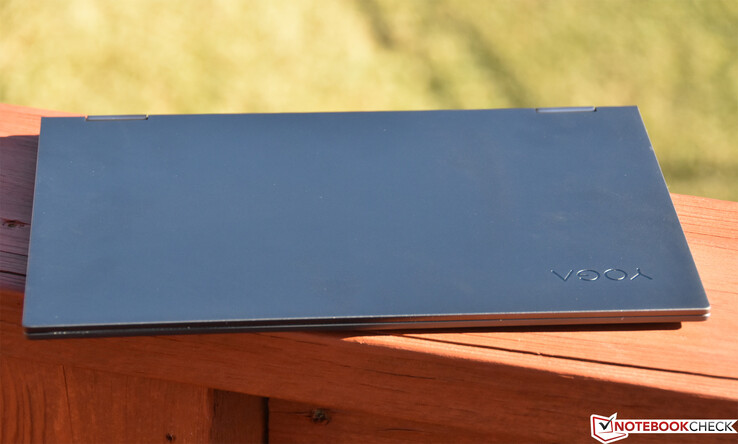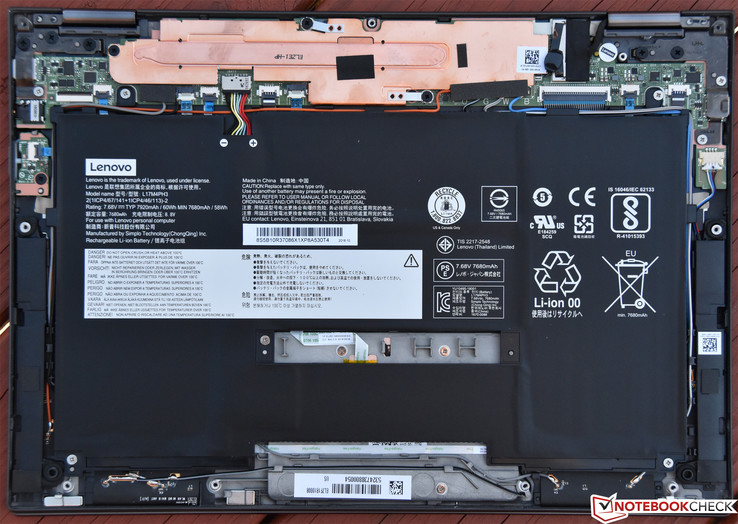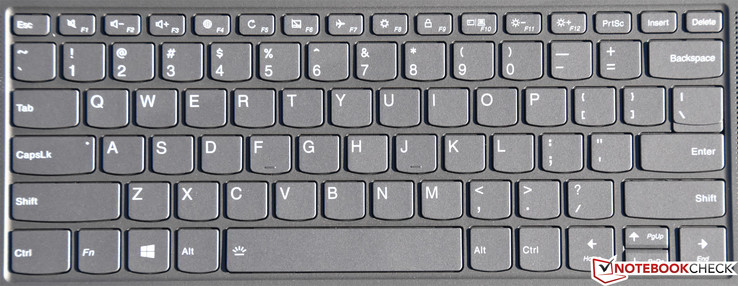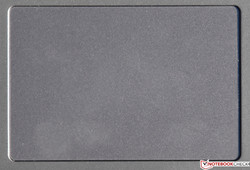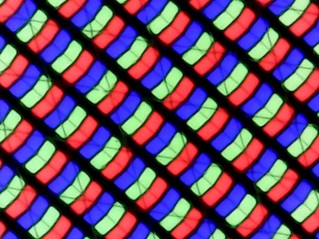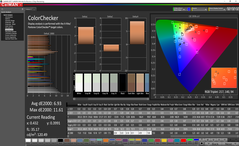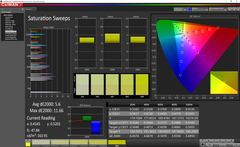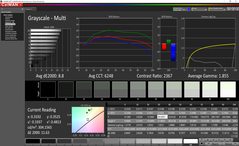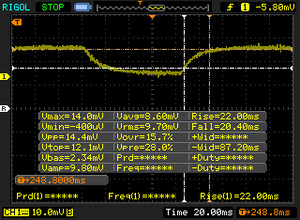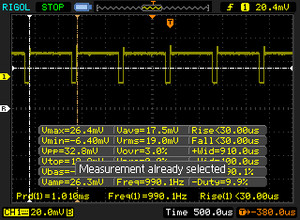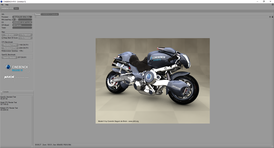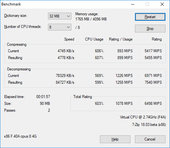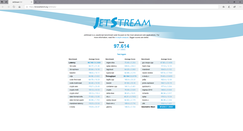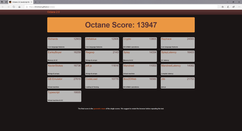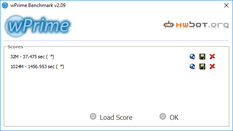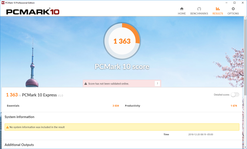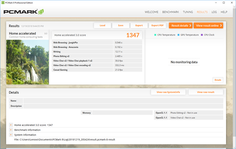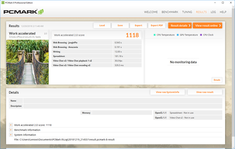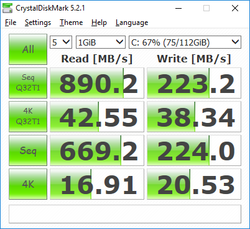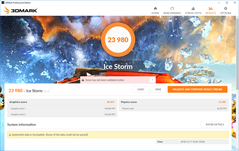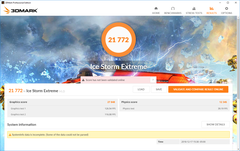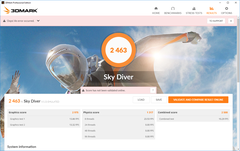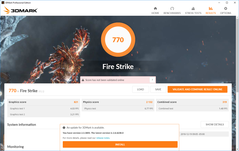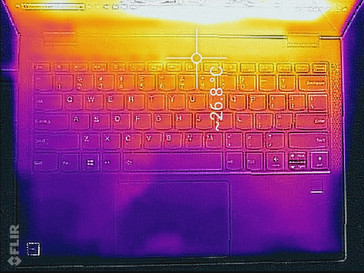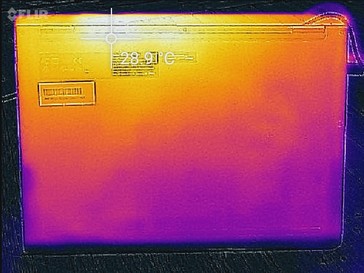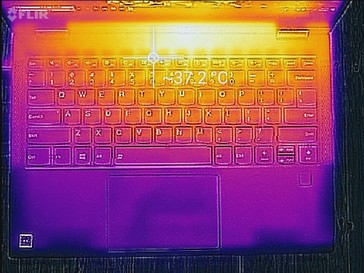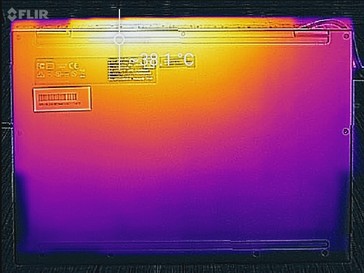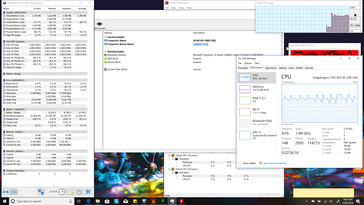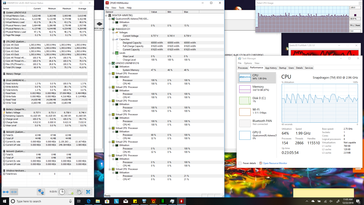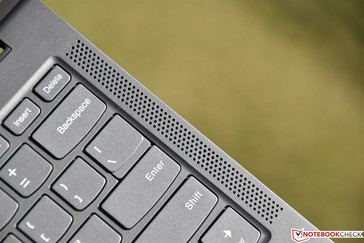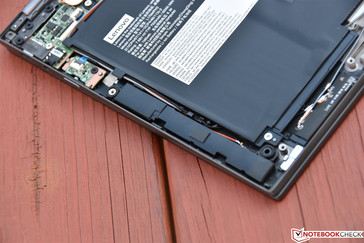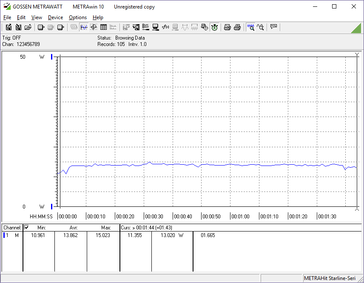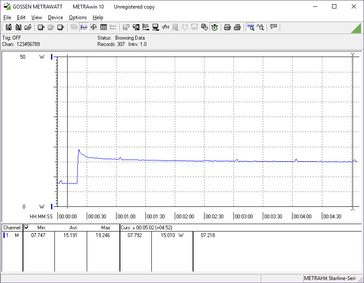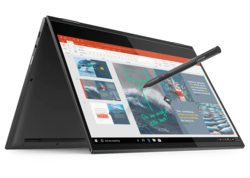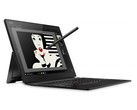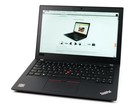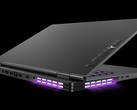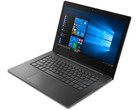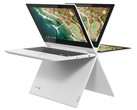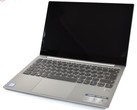Lenovo Yoga C630 WOS (Snapdragon) Convertible Review
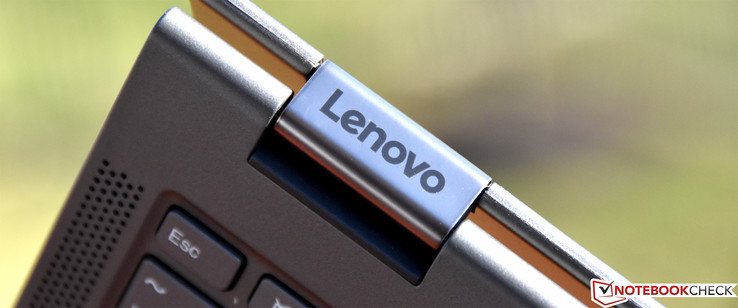
The continued endurance of the personal computer has to thank, at least in part, the persistent innovation of manufacturers as they continue to encroach the territory of competing devices such as phones and tablets. Ultra-portable laptops aren’t a new thing, with numerous models sporting paper-thin designs and a weight hovering around the 3 lb. (1.36 kg) mark. But today, passively-cooled, silent, and “always-on” (a.k.a. Connected Standby) devices are growing in number—and with the newest chips from companies like Qualcomm, they might just be powerful enough to ride alongside their Intel-equipped counterparts to the office or school.
Lenovo’s Yoga C630 WOS (which stands for Windows on Snapdragon) is the latest addition to this growing field of hyper-portable laptops, and it certainly makes a statement right from the start. Its attractive aluminum case is one of the thinnest around, and performance seems quite good for such a tiny laptop without the luxury of a cooling fan. This is all thanks to the Qualcomm Snapdragon 850 SoC powering it, a chip that’s also responsible for some pretty terrific battery runtimes (which we’ll get to in a bit). Our $940 review unit also came equipped with 8 GB of RAM, 128 GB UFS 2.1 Samsung storage, and a Verizon SIM card (for use with the integrated Snapdragon X20 LTE modem). This configuration also ships with a Lenovo Active Pen, though we didn’t receive one with our review unit.
If everything falls into place, this could be a tough package to beat for road warriors or college students interested in a highly portable daily driver to get the job done. But enough speculation; let’s see how the Yoga C630 stands up to our comprehensive bevy of benchmarks, tests, and measurements!
Case
The Yoga C630 is constructed out of aluminum and magnesium, with clean surfaces and restrained styling that is both professional and attractive. Weighing just 1.204 kg (2.65 lb.), the C630 is also just 8 mm thick—one of the very slimmest notebooks currently on the market. The entire base unit is also coated with a comfortable soft-touch paint, an approach which both enhances its feel (and grip) and helps to mitigate the sometimes harsh cold of the metallic surfaces.
Despite its compactness, the C630 feels solid and stable, especially when resting on a hard surface. This is thanks in part to its long horizontal rubber feet, both of which span the width of the machine’s underside. But the device also offers moderate torsion resistance; even the display feels mostly well-protected, and no distortions are visible on the panel with pressure from behind. The hinges are tightly-tuned and do an excellent job of suppressing collateral vibrations during use. They also accommodate 360-degree rotation to transform the laptop into a tablet or transition to the now-familiar Tent and Stand modes. Such transformations happen quickly and flawlessly, and with the inclusion of the Lenovo Active Pen and the aforementioned featherweight build of the C630, they’re likely to come in handy, especially in a classroom environment.
Connectivity
The first big sacrifice necessitated primarily by the C630’s paper-thin design is that of port selection. Apart from the nano SIM port, all that’s left is the 3.5 mm combo audio jack and two USB Type-C ports, both of which are capable of only Gen 1 speeds. Either of the two USB Type-C ports can accept an AC adapter, and they’re located on opposite edges (left/right)—so that makes for convenient charging. The one on the right edge can also be used for video output via DisplayPort over USB-C. Anything more will require an adapter, however. Lenovo sells these (see their cleverly-designed USB-C Travel Hub adapter, $60), but of course, any number of third-party options will also suffice.
Communication
Thanks to the integrated Snapdragon X20 LTE modem, the Yoga C630 doesn’t require a Wi-Fi connection (or a hotspot) for internet functionality. The new modem is capable of up to 1.2 Gbps download speeds and is purportedly up to 70% faster in areas with weak LTE cellular signal conditions. Our review unit also arrived with a Verizon SIM card included, so it was ready to rock out of the box. However, it’ll work with any carrier provided a compatible SIM card is installed. All Yoga C630 configurations include the LTE modem; it’s part of the Qualcomm chipset.
Of course, conventional Wi-Fi is also on board. The internal Qualcomm dual-band 802.11ac 2x2 adapter performs well and is also capable of Bluetooth 4.2 connectivity. It’s capable of peak speeds of 867 Mbps and supports typical WLAN features such as MU-MIMO and 20/40/80 MHz channel widths.
Security
The Yoga C630 includes a touch fingerprint reader, which works quickly and effortlessly.
Accessories
Apart from the 45 W USB-C AC adapter, all current C630 configurations also include a Lenovo Active Pen, which leverages N-Trig technology (a competitor to the more widely-adopted Wacom, but shared with Microsoft’s Surface Pen, which makes the two products interchangeable). We’ve tested versions of the Active Pen in past reviews but we didn’t receive one with today’s C630 test unit.
Maintenance
Not much maintenance is possible or even necessary on the Yoga C630. To Lenovo’s credit, the bottom panel of the machine is removable—it’s secured by nine Torx screws and an assortment of particularly stubborn clips around the perimeter—but not much of interest is available underneath anyway. Inside, you’ll find just the (massive) battery, the heat spreader, the tiny motherboard, the speakers, and… that’s pretty much it. The storage and memory are both soldered to the board and cannot be replaced or upgraded, and there’s no fan to clean or replace, either.
Warranty
The Lenovo Yoga C630 includes a 1-year depot warranty. As usual, upgrades are available for an added cost. Please see our Guarantees, Return policies and Warranties article for country-specific information.
Input Devices
Keyboard
Lenovo’s heralded proficiency with input devices finds little compromise in the Yoga C630. Starting with the (full-sized) keyboard, in true AccuType fashion, key surfaces are slightly larger than normal (to prevent missed keystrokes), and the smooth surfaces are comfortable to the touch. Visibility is very good thanks to the dark grey color with white lettering; there’s also a two-stage backlight available. Actuation force is consistent across the breadth of the keyboard, even for the corner keys such as ESC and Delete. Key travel is short, but feedback is palpable, so it’s not too difficult to adjust to typing on the laptop after spending a short amount of time with it. Keystrokes are quiet and well-suited to office and classroom environments. This is definitely more comparable to an IdeaPad keyboard than a superior ThinkPad keyboard, but it’s good nonetheless.
Touchpad
The large 105 x 69 mm Elan touchpad uses Microsoft Precision drivers and is therefore as responsive as you’d expect, with practically no lag and effortless gesture interpretation. Perhaps of more interest, then, are the integrated buttons; the bottom of the pad is clickable, and we find no complaints with collateral cursor movement as a result of depressions. The pad also expertly handles palm rejection, so you needn’t worry about problems typing while the touchpad is enabled. The Yoga also naturally incorporates a touchscreen.
Display
The sole display option for the Yoga C630 is an FHD (1920x1080) IPS screen with a glossy edge-to-edge finish. Some of our normal measurements of the screen’s properties aren’t possible thanks to software incompatibilities with the chipset, but subjectively speaking, the colors appear moderately vivid, suggesting a decent coverage of the sRGB spectrum. It can’t compete with the upgraded display panels on higher-end Ultrabooks (such as the X1 Carbon/Extreme, Spectre 13, or XPS 13), but it’s good enough for more users. Backlight bleed is only visible in the corners, and it’s not very pronounced.
| |||||||||||||||||||||||||
Brightness Distribution: 90 %
Center on Battery: 303 cd/m²
Contrast: 1782:1 (Black: 0.17 cd/m²)
ΔE ColorChecker Calman: 6.93 | ∀{0.5-29.43 Ø4.78}
ΔE Greyscale Calman: 8.8 | ∀{0.09-98 Ø5}
Gamma: 1.855
CCT: 6248 K
| Lenovo Yoga C630 (Snapdragon) M133NWF4-R0, IPS, 13.3", 1920x1080 | Asus ZenBook 13 UX331UN AU Optronics B133HAN04.9, IPS, 13.3", 1920x1080 | Dell XPS 13 9370 FHD i5 SHP1484, IPS, 13.3", 1920x1080 | Lenovo Yoga 730-13IKB-81CT LGD05B4 (LP133WF4-SPB8), IPS, 13.3", 1920x1080 | HP Spectre x360 13t-ae000 LGD0588, IPS, 13.3", 3840x2160 | Acer Chromebook R13 CB5-312T-K0YK IPS, 13.3", 1920x1080 | |
|---|---|---|---|---|---|---|
| Display | ||||||
| Display P3 Coverage (%) | 63.3 | 68.9 | 65.6 | 71.9 | ||
| sRGB Coverage (%) | 86.7 | 96.6 | 83.9 | 98.1 | ||
| AdobeRGB 1998 Coverage (%) | 63.4 | 69.6 | 61.4 | 73.1 | ||
| Response Times | 11% | -45% | 21% | -12% | 19% | |
| Response Time Grey 50% / Grey 80% * (ms) | 42.4 ? | 44 ? -4% | 62.4 ? -47% | 34 ? 20% | 51.6 ? -22% | 38 ? 10% |
| Response Time Black / White * (ms) | 32 ? | 24 ? 25% | 45.6 ? -43% | 25.2 ? 21% | 32.4 ? -1% | 23 ? 28% |
| PWM Frequency (Hz) | 990 ? | 1008 ? | ||||
| Screen | 6% | 19% | -10% | 16% | -17% | |
| Brightness middle (cd/m²) | 303 | 329 9% | 428 41% | 301 -1% | 329.8 9% | 192 -37% |
| Brightness (cd/m²) | 288 | 306 6% | 405 41% | 295 2% | 318 10% | 204 -29% |
| Brightness Distribution (%) | 90 | 86 -4% | 87 -3% | 91 1% | 74 -18% | 88 -2% |
| Black Level * (cd/m²) | 0.17 | 0.3 -76% | 0.26 -53% | 0.36 -112% | 0.25 -47% | 0.23 -35% |
| Contrast (:1) | 1782 | 1097 -38% | 1646 -8% | 836 -53% | 1319 -26% | 835 -53% |
| Colorchecker dE 2000 * | 6.93 | 4.07 41% | 3.8 45% | 6.02 13% | 2.37 66% | |
| Colorchecker dE 2000 max. * | 11.61 | 7.05 39% | 7.2 38% | 11.36 2% | 4.08 65% | |
| Greyscale dE 2000 * | 8.8 | 2.76 69% | 4.4 50% | 2.9 67% | 2.8 68% | 3.99 55% |
| Gamma | 1.855 119% | 2.56 86% | 2.21 100% | 1.96 112% | 2.145 103% | 2.45 90% |
| CCT | 6248 104% | 6915 94% | 7067 92% | 6408 101% | 6441 101% | 6380 102% |
| Color Space (Percent of AdobeRGB 1998) (%) | 56 | 62.8 | 61.38 | 67 | ||
| Color Space (Percent of sRGB) (%) | 86 | 96.4 | 83.92 | 98 | ||
| Colorchecker dE 2000 calibrated * | 4.74 | |||||
| Total Average (Program / Settings) | 9% /
7% | -13% /
6% | 6% /
-4% | 2% /
10% | 1% /
-8% |
* ... smaller is better
Brightness and contrast also seem mostly good, and our measurements agree: we record 288 cd/m² average brightness with a good distribution of 90% across the panel alongside a very good contrast ratio of 1782:1 (black value: 0.17 cd/m²). This, combined with the reasonably good color coverage and glossy finish, makes for a rather punchy picture in spite of the merely middling luminosity.
Our analysis using CalMAN professional calibration software reveals Colorchecker and Greyscale DeltaE values of 6.93 and 8.8, neither of which is great, though it certainly isn’t awful. The max Colorchecker DeltaE of 11.61 is claimed by White, which is a bit on the yellowish side. Gamma is also somewhat deviant toward the low end with just 1.855 measured (2.2 is ideal), though the CCT Average of 6248 (ideal: 6500) indicates a good overall color temperature for the panel. Most other (more expensive) Ultrabook display panels in today’s comparison field are better, both in terms of brightness/contrast and color reproduction. Still, the Yoga C630 is mostly inoffensive in its performance, and most users aren’t going to mind its shortcomings.
Display Response Times
| ↔ Response Time Black to White | ||
|---|---|---|
| 32 ms ... rise ↗ and fall ↘ combined | ↗ 17.6 ms rise | |
| ↘ 14.4 ms fall | ||
| The screen shows slow response rates in our tests and will be unsatisfactory for gamers. In comparison, all tested devices range from 0.1 (minimum) to 240 (maximum) ms. » 85 % of all devices are better. This means that the measured response time is worse than the average of all tested devices (20.2 ms). | ||
| ↔ Response Time 50% Grey to 80% Grey | ||
| 42.4 ms ... rise ↗ and fall ↘ combined | ↗ 22 ms rise | |
| ↘ 20.4 ms fall | ||
| The screen shows slow response rates in our tests and will be unsatisfactory for gamers. In comparison, all tested devices range from 0.165 (minimum) to 636 (maximum) ms. » 69 % of all devices are better. This means that the measured response time is worse than the average of all tested devices (31.6 ms). | ||
Screen Flickering / PWM (Pulse-Width Modulation)
| Screen flickering / PWM detected | 990 Hz | ≤ 98 % brightness setting | |
The display backlight flickers at 990 Hz (worst case, e.g., utilizing PWM) Flickering detected at a brightness setting of 98 % and below. There should be no flickering or PWM above this brightness setting. The frequency of 990 Hz is quite high, so most users sensitive to PWM should not notice any flickering. In comparison: 53 % of all tested devices do not use PWM to dim the display. If PWM was detected, an average of 8108 (minimum: 5 - maximum: 343500) Hz was measured. | |||
Panel response times are slow, as is often the case for non-gaming grade IPS displays. We also detected PWM in use at all brightness levels below 98% (essentially full brightness), but the frequency of 990.1 Hz is high enough that most sensitive users probably won’t be bothered by it.
Outdoors, the display struggles thanks to its high-gloss finish. Shaded areas are fine provided care is taken to accommodate for glare from any light sources. Viewing angles are excellent, as expected from an IPS display.
Performance
Lenovo’s Yoga C630 WOS convertible is only the second machine on the market to incorporate Qualcomm’s Snapdragon 850 mobile compute platform (the first being Samsung’s Galaxy Book 2, which we’ve yet to review). Qualcomm’s gunning for Intel’s market share with the help of their ultra-efficient ARM architecture (aided by a 2nd generation 10 nm process from Samsung) and little bonus luxuries such as “always-on, always-connected” (Connected Standby) capability. Connected Standby allows the machine to enter a sort of hybrid sleep state, where data connections still take place and the laptop is immediately wakeable via an opening of the display lid or a press of the power button. Such features have long been taken for granted on ubiquitous phones and tablets, but they’ve yet to become commonplace on laptops. Once you’ve experienced it, it’s true that it is rather jarring to revert to conventional S3 sleep states (or, god forbid, S4 hibernation), which takes at minimum a few seconds to emerge from. The Yoga C630 is an uncommonly convenient companion for road warrior and inter-classroom use in this sense; just open it up, use it for a moment, and close it back without ever having to worry about a delay in sleep/wake cycles.
As we mentioned previously, what you choose is what you’re stuck with when it comes to the C630’s internal components; no upgrades to RAM or storage are possible.
Processor
The C630’s octacore Snapdragon 850 features a clock speed of up to 2.96 GHz (8x Kryo 385 CPUs) with a 64-bit architecture. Qualcomm heralds the Snapdragon 850 as providing a 25% increase in battery life and 30% faster graphics/processing speeds versus the previous generation Snapdragon 835, not to mention 4-5x lower power consumption in connected standby as compared to competing solutions. That’s all good news, because the Snapdragon 835 wasn’t exactly the quickest of chips when compared to its Intel counterparts.
Speed concerns aside, given that it’s an ARM-based processor, compatibility compromises do apply. During our testing, a number of tests refused to run, leaving us to rely on other data for assessments of the machine’s capabilities. It’s true that the vast majority of conventional applications will run, but don’t expect x86-level compatibility. The machine comes with Windows 10 S Mode enabled by default—in which only apps acquired from the Windows Store will run on the machine (for performance, efficiency, and security’s sake). But it’s trivial to transition out of S Mode and “upgrade” to full-blown Windows 10 Pro, as long as you keep in mind it’s a one-way street.
Even the benchmarking apps that did run on our test machine by and large were unable to measure ARM-specific performance, with the exception of Geekbench 4. The conventional tests such as the Cinebench routines, wPrime, and super Pi aren’t kind to the Snapdragon 850, which only has its chance to shine when nestled within the confines of its specific architecture. For example, in Geekbench 4, the C630 scores 2234 points (single) and 6980 (multi) when operating in ARM mode—but in x86, those scores drop to roughly half: just 1296 (single) and 3386 (multi).
A quick test of a 60 fps 4K video from YouTube in Chrome revealed proper hardware acceleration in play: CPU usage rose to around 13 to 16% within Chrome, but the Adreno 630 GPU Video Decode process leaped to 80%. The video played smoothly without any hiccups or interruptions.
| wPrime 2.10 - 1024m | |
| Lenovo Yoga C630 (Snapdragon) | |
| Average Qualcomm Snapdragon 850 (n=1) | |
| HP Spectre x360 13t-ae000 | |
| Lenovo Yoga 730-13IKB-81CT | |
| Average of class Convertible (84.3 - 347, n=4, last 2 years) | |
| Geekbench 4.4 | |
| 64 Bit Single-Core Score | |
| Asus ZenBook 13 UX331UN | |
| Lenovo Yoga C630 (Snapdragon) | |
| Average Qualcomm Snapdragon 850 (n=1) | |
| 64 Bit Multi-Core Score | |
| Asus ZenBook 13 UX331UN | |
| Lenovo Yoga C630 (Snapdragon) | |
| Average Qualcomm Snapdragon 850 (n=1) | |
* ... smaller is better
Cinebench R11.5 awards the C630 just 0.51 points / 1.1 points in single and multi-core, respectively—versus category averages of 1.107 and 2.76 points, or 117% / 151% higher. The C630 took nearly three times as long (1456 s) as the Yoga 730 to complete the 1024m computation in wPrime 2.0, and it didn’t complete super Pi until 1678 s had elapsed (versus 783 s for the Yoga 730). Stated plainly, in today’s x86-optimized applications, the Snapdragon 850 just plain can’t compete with Intel’s chips. But for basic tasks and anything optimized for the ARM architecture, it’ll be just fine.
One more quick note: since we were unable to run Cinebench R15 on this machine, we couldn’t complete our usual CB15 multi-CPU loop test. Instead, we’ll estimate/project the likely implications of sustained loads on the machine later on in our Stress Test section.
System Performance
PCMark’s measurements—again, focused on x86 operation—correspondingly come up significantly short of the competition. Whereas the Yoga 730 manages 4031 points in its PCMark 10 Overall Score, the Snapdragon-powered C630 scores just 1363, roughly 1/3. The rest of the field is also at least twice as fast, with the ZenBook 13 coming in closest to the C630 with 3160 points—still 132% ahead. PCMark 8 agrees, assigning the C630 a Work Score of 1118 points and a Home Score of 1347, again, the latter which is close to the PCMark 10 margins, and the former which is even farther off the mark.
These discrepancies are partially a product of storage speed, too, as we’ll see in the next section. But surely processing speeds are a substantial constituent, since we’ve previously witnessed plenty of machines with slower (or comparable) storage drives perform better in PCMark’s synthetic tests.
But what about subjective performance? It’s a mixed bag to be sure. Some operations, such as booting the OS, sleep/resume (which we covered previously—boosted by Connected Standby capabilities), ARM-optimized apps (such as Microsoft Office, Edge, etc.), and general navigation within Windows seem nice and quick. Others, such as installing many programs, running most benchmarks, and third-party apps like Adobe’s Creative Suite sometimes feel incredibly slow, however. It’s a strange dichotomy of experiences alongside the impressive form factor, passive cooling, and relatively high price tag of the C630. Your mileage may vary, and specifically in relation to your unique usage profile.
| PCMark 8 Home Score Accelerated v2 | 1347 points | |
| PCMark 8 Work Score Accelerated v2 | 1118 points | |
| PCMark 10 Score | 1363 points | |
Help | ||
Storage Devices
The Yoga C630 leverages Samsung’s latest generation of eUFS for storage. Universal Flash Storage is situated someplace between eMMC and SSD storage in terms of performance, and eUFS (which utilizes version 3.0 of the UFS standard) is among the fastest solutions on the market. While sequential read speeds from the embedded flash chip in our review unit bear this out (890.2 MB/s in CDM 5.2 Seq Q32T1), the rest of the statistics quickly reveal a gap in storage performance. While write speeds across the board are merely mediocre (223.2 MB/s Seq Q32T1), this discrepancy is most evident in 4K performance (both QD 1 and 32): we measure just 42.55 MB/s and 38.34 MB/s in Read/Write 4K Q32T1, almost 1/10 the performance of some competitors. By comparison, the Yoga 730 achieves 345 MB/s and 377.9 MB/s in that same benchmark—roughly 9 times as fast.
As a reminder, the storage in the C630 can’t be upgraded or replaced—and no SD card slot is available either, so you’re basically stuck with the stock internal eUFS solution unless you elect to carry an external SSD of some sort with you. It’s fine for everyday use, but its insufficiencies can definitely be felt during any heavier I/O.
| Lenovo Yoga C630 (Snapdragon) | Asus ZenBook 13 UX331UN SK Hynix HFS256G39TND-N210A | Dell XPS 13 9370 FHD i5 Toshiba XG5 KXG50ZNV256G | Lenovo Yoga 730-13IKB-81CT Toshiba XG5 KXG50ZNV256G | HP Spectre x360 13t-ae000 Lite-On CA1-8D256-HP | |
|---|---|---|---|---|---|
| CrystalDiskMark 5.2 / 6 | |||||
| Write 4K (MB/s) | 20.53 | 78.4 282% | 128.2 524% | 148.5 623% | 129.5 531% |
| Read 4K (MB/s) | 16.91 | 30.77 82% | 48.09 184% | 27.48 63% | 37.8 124% |
| Write Seq (MB/s) | 224 | 264.5 18% | 1088 386% | 395.5 77% | 1008 350% |
| Read Seq (MB/s) | 669 | 465.7 -30% | 1877 181% | 1967 194% | 1582 136% |
| Write 4K Q32T1 (MB/s) | 38.34 | 262.8 585% | 367.1 857% | 345 800% | 410 969% |
| Read 4K Q32T1 (MB/s) | 42.55 | 283.8 567% | 411.9 868% | 377.9 788% | 493.4 1060% |
| Write Seq Q32T1 (MB/s) | 223.2 | 262.7 18% | 1078 383% | 425.5 91% | 1029 361% |
| Read Seq Q32T1 (MB/s) | 890 | 559 -37% | 2771 211% | 2500 181% | 2429 173% |
GPU/Gaming Performance
Packaged with the Snapdragon 850 Mobile Compute Platform is the Qualcomm Adreno 630 GPU, which Qualcomm claims is roughly 30% faster than the previous generation. Performance in our benchmarks is once again far below that of the Intel chips, but there are a couple of bright spots that do showcase the possibilities of the new platform. Specifically, 3DMark Fire Strike scores the Adreno 821 points, which is only 23% below the HP Spectre 13 x360 and 25% below the Dell XPS 13. Other benchmarks are less positive, such as 3DMark Ice Storm, where the Yoga 630 only manages to score 23980 points—less than a third of the Yoga 730’s 79073 points.
A number of other benchmarks failed to run due to compatibility reasons, including 3DMark 06, 3DMark 11, 3DMark Vantage, and Cinebench R15. Of course, gaming isn’t much of a possibility anyway thanks to the passive cooling of the chipset (which renders sustained performance under heavy loads problematic); Bioshock Infinite did run, but it only achieved 20 fps on low (1280x720, Very Low preset)—unplayable, and it’s a game from 2013, too.
So, unsurprisingly, the Adreno’s improved GPU capabilities aren’t likely to benefit the user in most ways apart from accelerated application performance, such as web browsers and image editing programs.
| 3DMark Ice Storm Standard Score | 23980 points | |
| 3DMark Cloud Gate Standard Score | 3108 points | |
| 3DMark Fire Strike Score | 770 points | |
Help | ||
Gaming Performance
The Lenovo Yoga C630 is not really suited for gaming due to the Snapdragon SoC. For one the GPU is not that beefy and on the other hand there are nearly no games that are available as 64 Bit ARM versions (in mid 2019). In our tests e.g. we tried Hearthstone and even in 1024x768 and low details there were a lot of frame drops and stuttering. Still, due to the slow nature of the card game, we would still call it playable.
| BioShock Infinite | |
| 1280x720 Very Low Preset | |
| Lenovo Yoga C630 (Snapdragon) | |
| Average Qualcomm Adreno 630 (n=1) | |
| 1366x768 Medium Preset | |
| Lenovo Yoga C630 (Snapdragon) | |
| Average Qualcomm Adreno 630 (n=1) | |
| 1366x768 High Preset | |
| Lenovo Yoga C630 (Snapdragon) | |
| Average Qualcomm Adreno 630 (n=1) | |
| 1920x1080 Ultra Preset, DX11 (DDOF) | |
| Lenovo Yoga C630 (Snapdragon) | |
| Average Qualcomm Adreno 630 (n=1) | |
| low | med. | high | ultra | |
|---|---|---|---|---|
| Diablo III (2012) | 10.3 | |||
| BioShock Infinite (2013) | 20 | 14 | 13 | 4 |
| Thief (2014) | 6 | 5 | 5 | 3 |
| League of Legends (2019) | 0 game wont start | |||
| Hearthstone (2020) | 29.3 | 27.8 |
Emissions
System Noise
The Yoga C630 is a passively-cooled (fanless) machine and therefore is completely silent. We detected absolutely no electrical noise from the unit at any point during our testing.
Temperature
As we’ve said previously, the Yoga C630 employs only a heat spreader to cool its chipset. This approach can lead to challenges under sustained loads, but the C630 manages to stay reasonably cool even under heavier loads, with average temperatures of just 26.8 °C and 29.2 °C on top and bottom, respectively. Hot spots of 36 °C / 38.2 °C exist in the top center quadrants of the top/bottom (as this is where the processor is located), but the two adjacent quadrants remain coo enough to the touch so as to render lap-based use practical in any scenario. Meanwhile, when idling, averages are just 24.3 °C / 26 °C top/bottom (versus room temperatures of 20 °C).
(+) The maximum temperature on the upper side is 36 °C / 97 F, compared to the average of 35.4 °C / 96 F, ranging from 19.6 to 60 °C for the class Convertible.
(+) The bottom heats up to a maximum of 38.2 °C / 101 F, compared to the average of 36.8 °C / 98 F
(+) In idle usage, the average temperature for the upper side is 24.3 °C / 76 F, compared to the device average of 30.3 °C / 87 F.
(+) The palmrests and touchpad are cooler than skin temperature with a maximum of 23 °C / 73.4 F and are therefore cool to the touch.
(+) The average temperature of the palmrest area of similar devices was 27.9 °C / 82.2 F (+4.9 °C / 8.8 F).
Stress Test
Analyzing the Yoga C630 under synthetic stress proved challenging thanks to software compatibility issues. Firstly, we were unable to synthetically stress the GPU, but that didn’t matter because we couldn’t find a way to reliably read the GPU current clock rates anyway. Temperatures fell under the same umbrella: as far as we can tell, there’s no software currently available that can accurately report the temperature of the Snapdragon processor.
So instead, we decided to apply full CPU stress (which worked) and monitor clock rates over a sustained period instead. Here, we see the CPU at first achieving 2.1 GHz with approximately 80% utilization for just a couple of precious seconds before it immediately subsides to 1.9 – 2.06 GHz with ~63% util on average. Fluctuations in utilization become more pronounced as time goes on (see our screenshot, which depicts operation under stress about a minute in; note the peaks and valleys).
Performance only degrades marginally beyond this after around 15 minutes of operation, though stopping the test seemed to result in a GPU hiccup as all video froze for around 60 seconds before the machine suddenly came to life again. So there seem to be some deeper wrinkles in play associated with the Qualcomm chipset’s comingling with the Windows OS, however uncommon or unlikely they may be.
Speakers
The Yoga C630’s speakers aren’t bad in a pinch. They manage decent volume levels with a measured 78.88 dB of loudness, but the sound is far from linear across the entire spectrum. As we often suggest for these small laptops, if any sort of extended listening is in store, a good pair of headphones is warranted.
Lenovo Yoga C630 (Snapdragon) audio analysis
(±) | speaker loudness is average but good (78.9 dB)
Bass 100 - 315 Hz
(±) | reduced bass - on average 11.4% lower than median
(±) | linearity of bass is average (8.9% delta to prev. frequency)
Mids 400 - 2000 Hz
(±) | higher mids - on average 11.7% higher than median
(-) | mids are not linear (18.5% delta to prev. frequency)
Highs 2 - 16 kHz
(±) | higher highs - on average 9.3% higher than median
(-) | highs are not linear (28% delta to prev. frequency)
Overall 100 - 16.000 Hz
(-) | overall sound is not linear (48.4% difference to median)
Compared to same class
» 99% of all tested devices in this class were better, 1% similar, 0% worse
» The best had a delta of 6%, average was 20%, worst was 57%
Compared to all devices tested
» 96% of all tested devices were better, 0% similar, 4% worse
» The best had a delta of 4%, average was 24%, worst was 134%
Dell XPS 13 9370 FHD i5 audio analysis
(+) | speakers can play relatively loud (82.8 dB)
Bass 100 - 315 Hz
(-) | nearly no bass - on average 18.6% lower than median
(±) | linearity of bass is average (11.1% delta to prev. frequency)
Mids 400 - 2000 Hz
(±) | higher mids - on average 5.3% higher than median
(+) | mids are linear (3.8% delta to prev. frequency)
Highs 2 - 16 kHz
(+) | balanced highs - only 3.9% away from median
(+) | highs are linear (6.4% delta to prev. frequency)
Overall 100 - 16.000 Hz
(±) | linearity of overall sound is average (18.2% difference to median)
Compared to same class
» 51% of all tested devices in this class were better, 7% similar, 41% worse
» The best had a delta of 5%, average was 18%, worst was 53%
Compared to all devices tested
» 38% of all tested devices were better, 8% similar, 54% worse
» The best had a delta of 4%, average was 24%, worst was 134%
Energy Management
Power Consumption
Perhaps a premonition of what to expect in our Battery Life section to follow, power consumption measurements from the Yoga C630 aren’t quite as low as we might have expected. The idle average of 7.7 W is actually higher than both the Asus ZenBook 13 and XPS 13, but under load, the average power consumption of 13.8 W is well below that of all competitors other than the MT8173C-equipped Acer Chromebook R13, which is still only slightly less power-hungry (11 W) regardless of the Snapdragon’s vastly more capable speeds.
It’s worth mentioning that all of today’s measurements were performed (out of necessity in most cases) outside of Windows 10 S Mode (and therefore in conventional Windows 10 mode), so you may be able to expect better power efficiency in the “stock” Windows 10 S Mode—though we doubt most users will remain there regardless thanks to the stringent application limitations.
| Off / Standby | |
| Idle | |
| Load |
|
Key:
min: | |
| Lenovo Yoga C630 (Snapdragon) SD 850, Adreno 630, , IPS, 1920x1080, 13.3" | Asus ZenBook 13 UX331UN i5-8550U, GeForce MX150, SK Hynix HFS256G39TND-N210A, IPS, 1920x1080, 13.3" | Dell XPS 13 9370 FHD i5 i5-8250U, UHD Graphics 620, Toshiba XG5 KXG50ZNV256G, IPS, 1920x1080, 13.3" | Lenovo Yoga 730-13IKB-81CT i5-8250U, UHD Graphics 620, Toshiba XG5 KXG50ZNV256G, IPS, 1920x1080, 13.3" | HP Spectre x360 13t-ae000 i5-8550U, UHD Graphics 620, Lite-On CA1-8D256-HP, IPS, 3840x2160, 13.3" | Acer Chromebook R13 CB5-312T-K0YK MT8173C, PowerVR GX6250, 32 GB eMMC Flash, IPS, 1920x1080, 13.3" | |
|---|---|---|---|---|---|---|
| Power Consumption | -43% | -51% | -128% | -68% | 20% | |
| Idle Minimum * (Watt) | 4.4 | 2.2 50% | 3.14 29% | 8.5 -93% | 5.9 -34% | 3.8 14% |
| Idle Average * (Watt) | 7.7 | 5 35% | 5.22 32% | 11.8 -53% | 9.8 -27% | 6.2 19% |
| Idle Maximum * (Watt) | 7.8 | 8 -3% | 6 23% | 13.1 -68% | 10.6 -36% | 6.6 15% |
| Load Average * (Watt) | 13.8 | 33 -139% | 38.5 -179% | 51.1 -270% | 36.6 -165% | 11 20% |
| Load Maximum * (Watt) | 19.3 | 49.4 -156% | 50.4 -161% | 49 -154% | 34.3 -78% | 12.7 34% |
* ... smaller is better
Battery Life
Qualcomm and Lenovo promise long battery runtimes from the Yoga C630, and while our test results come nowhere near the “up to 25 hours” number seen in official marketing materials, such a result is surely only possible under the most frugal of settings within Windows 10 S Mode.
Instead, we record 11 hours and 51 minutes of runtime in our standard Wi-Fi Web Surfing test, which is hours longer than nearly every other machine in our comparison field today. Meanwhile, the Acer Chromebook lasts longer, with 12 hours and 53 minutes—but at these values, it’s really just splitting hairs.
| Lenovo Yoga C630 (Snapdragon) SD 850, Adreno 630, 60 Wh | Asus ZenBook 13 UX331UN i5-8550U, GeForce MX150, 50 Wh | Dell XPS 13 9370 FHD i5 i5-8250U, UHD Graphics 620, 52 Wh | Lenovo Yoga 730-13IKB-81CT i5-8250U, UHD Graphics 620, 48 Wh | HP Spectre x360 13t-ae000 i5-8550U, UHD Graphics 620, 60 Wh | Acer Chromebook R13 CB5-312T-K0YK MT8173C, PowerVR GX6250, 53.9 Wh | |
|---|---|---|---|---|---|---|
| Battery runtime | -24% | -10% | -21% | -40% | 8% | |
| WiFi v1.3 (h) | 11.9 | 9 -24% | 10.7 -10% | 9.4 -21% | 7.1 -40% | 12.9 8% |
| Reader / Idle (h) | 20.7 | 23.6 | 15 | |||
| Load (h) | 1.8 | 2 | 1.6 | 2 |
Verdict
Pros
Cons
Lenovo’s Yoga C630 is another step toward Windows on ARM (or, in this case, Windows on Snapdragon—WOS) as a practical option, but it doesn’t come without an inevitable array of caveats. Chief among these is compatibility, which will probably prove to be an issue at least occasionally during the life of the system with any daily user. Parallel to that are the performance discrepancies, which can only be described accurately as dichotomous in nature: within apps optimized for ARM, the chip can be quite fast, but all the rest tend to crawl notably slower than their Intel counterparts. Problematically, the price doesn’t necessarily reflect the possible trials posed by these myriad works-in-progress: $900+ is a lot to ask for a computer than feels, at least in part, not completely ready for the big leagues.
The Yoga C630 boasts a unique set of advantages over traditional x86-powered machines, such as its extra-efficient Connected Standby implementation, highly portable form factor, and fanless design. But at such a high price, enduring application compatibility struggles and substantial performance discrepancies between ARM and x86 apps render its unconditional recommendation difficult.
There are a few other notable drawbacks, too. Port selection is notoriously limited, and maintenance/upgrades are all but impossible (given the monolithic nature of the internal components). Finally, one minor complaint is the storage, which—while faster than a hard drive or eMMC—isn’t really comparable to most modern SSDs thanks to lagging 4K and write performance at any queue depth.
However, there are lots of bright spots, too, and a few of them are major if you’re willing to deal with the challenges listed above. These are led by the nearly instantaneous sleep/resume times made possible by the Connected Standby features (termed “Always On, Always Connected” by Lenovo), as well as the capability of updating mail and other content while in standby. This feature alone will surely prove unfathomably enticing to road warriors and students who depends on their laptops for immediate availability at the drop of a hat.
Next up is the passive cooling, which not only renders the machine silent, but also reduces the likelihood of a mechanical failure (since nowadays the fan is so often the only remaining powered mechanical device in a laptop). Portability sees a major boost in turn thanks to the smaller form factor (made possible in part by the tiny mainboard and lack of a cooling fan) and lower weight. And finally, construction and input devices are very good overall. Performance and compatibility concerns notwithstanding, this laptop looks poised to compete with the heavyweights of Ultrabook fame.
In sum, conventional Intel-powered Ultrabooks absolutely have a major performance advantage still today (as of January 2019). But as ARM-optimized apps grow in number, there may come a time in the not too distant future (next Sunday A.D.?) where these performance gaps begin to suddenly narrow. Whether or not the unique advantages of the fanless, ultra-thin, always-on device trump the disadvantages of its inconsistent, flakily compatible, schizophrenic general performance is a decision that will have to be made on an individual user-by-user basis.
Lenovo Yoga C630 (Snapdragon)
- 01/03/2019 v6 (old)
Steve Schardein




